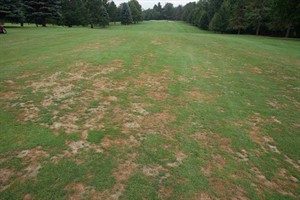With summer approaching, I thought I might give a recap of what the "summer of 2010" has been like for cool season turf in the United States.
This summer in the USA has been extremely difficult to maintain cool season turfgrasses throughout the United States especially on creeping bentgrass (Agrostis stolonifera) and Poa annua. If temperatures continue the summer of 2010 will go down as the hottest summer since the famous "Dust Bowl" year of 1934. Besides the heat it has been wet and humid. The dew point has been 10 percent higher than normal. This is reflective of a high relative humidity approaching that of the current air temperature.
In June, the beginning of summer here in the USA the impact from the weather was a breakout of almost all the warm weather diseases - brown patch, dollar spot, pythium blight, anthracnose, and as the summer progressed summer patch. Most of these diseases occurred 3 to 4 weeks earlier than normally expected. The symptoms were classic, in other words they looked just like what you would see in a textbook.
As the summer has progressed, the weather conditions have resulted in a steady decline of turf, especially creeping bentgrass/Poa annua greens. In most cases it is not disease related. The heat and humidity has predisposed plants to a chronic decline that has been accelerated due to wear and traffic.
Additionally, rootzone problems that may have not been a major problem in the past like black layer and excessive organic matter accumulation are contributing to the decline. Many of the golf courses are doing anything they can to slow this decline by skipping a mowing, raising the height of cut, switching to solid rollers and carefully watching how they are watering. It still surprises me the resistance to raising the height even fractionally by golf courses. The reason are numerous but do not make much sense when the result has been golf courses closing for 8 to 10 weeks.
A number of golf courses have not turned their irrigation system on around greens the entire summer. They are hand watering.
One interesting thing that is starting to be reported from the eastern United States through the Midwestern United States is bacterial wilt. Bacterial wilt is most often associated with Poa annua greens under stress.
Here in Ohio we are seeing it on Poa annua greens from Cleveland to Cincinnati, what is making golf course superintendents nervous is it is now being confirmed on some of the new creeping bentgrass cultivars established to greens that are newly established - four or five years old. The difficulty I have observed with this disease is there is nothing you can do to control it!
Photograph: Unfortunately, this has been a common site. The high temperatures have resulted in root loss. With the rainstorms that pass through, wet wilt becomes an issue.

